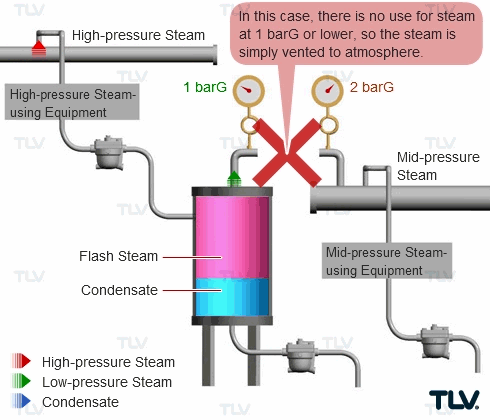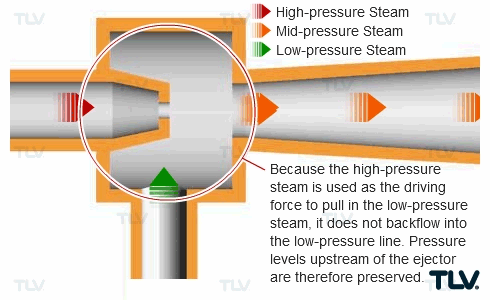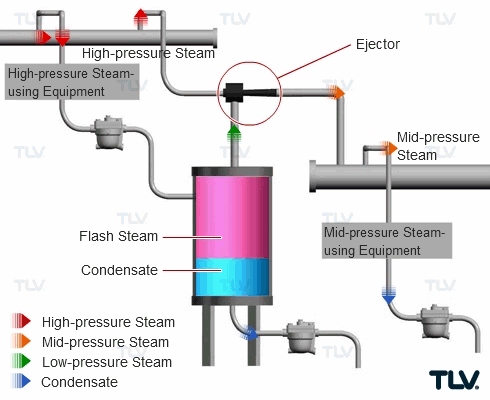- Home
- Steam Resources
- Steam Theory
- Steam Compressors
Other Equipment etc.
Steam Compressors
When medium to high pressure steam traps discharge condensate, the low pressure in the condensate recovery line causes some of the liquid to "flash" back into steam. This flash steam contains valuable heat energy that, if effectively re-used, can help to increase plant efficiency and reduce energy consumption. All too often, the flash steam may be vented to atmosphere, and the heat energy is subsequently wasted. However, there are two possible methods to retain the heat energy: flash recovery and steam compression.
One of the most common ways to capture the heat is by installing a pressurized flash tank or flash recovery system. The flash tank receives condensate discharged from the steam traps and allows the flash steam to be diverted into a low-pressure line for re-use elsewhere.
However, a flash recovery system results in a certain amount of backpressure; caution must be taken to preserve the necessary pressure differential upstream so that steam traps can continue to operate. Furthermore, there must also be an actual need for the low/mid-pressure steam provided by the flash tank. Sometimes, the pressure of the recovered flash steam is below the minimum pressure or temperature required for re-use. In such cases, a steam compressor can provide a more effective solution.
Flash Steam Pressure is Often Too Low for Re-use
After considering both the operating conditions required for the primary steam application and the discharge rate of the steam traps, there is sometimes a mismatch between the maximum flash steam pressure achievable and the minimum pressure required for re-use. For example, if flash steam pressure reaches a maximum of 1 barG and the minimum pressure that can be utilized is 2 barG, then the steam may be vented to atmosphere instead of re-used because the pressure is simply not high enough to meet the process threshold. If only the pressure could be raised from 1 barG to 2 barG, then the wasteful venting of steam could be avoided!

Raising Steam Pressure
In the case of air, an increase in pressure can easily be achieved using a standard air compressor. However, similar mechanical vapor compressors for steam are not very common due to the presence of condensate. Additionally, raising the pressure by simply adding heat is not possible, because adding heat without a containment enclosure (such as a boiler) merely causes the steam to become superheated and expand along the length of the piping without any increase in pressure. How, then, can the steam pressure be elevated?
One answer is to combine low-pressure steam with a higher pressure steam flow. Simply merging two flows by connecting the piping, however, will cause the higher pressure steam to backflow into the low-pressure line, which could cause problems for steam traps installed upstream. In order to prevent this backflow, it is necessary to use an ejector.
Using a Steam Ejector to Combine Low and High-pressure Steam
A steam ejector can be used to entrain low-pressure steam into a high-pressure steam flow while preventing backflow and pressure fluctuations upstream. A steam ejector sends high-pressure (motive) steam through a reduced passageway (nozzle), accelerating it and converting its pressure energy to velocity. This high velocity energy in turn creates a suction effect that will draw the low-pressure steam into the mixing chamber and entrain it into the motive flow. The increased mass of the combined steam flow causes velocity to decrease, and as the flow expands again through the diffuser section, the velocity energy is converted back to pressure energy.
| Ejector Mechanism |
|---|
|
|
| Combining Low and High-pressure Steam Flows |
|---|
|
|
In other words, a steam ejector uses thermocompression to mix flows of two different pressures and output steam at a mid-level pressure somewhere between those of the composite flows. This is what makes it possible to raise flash steam pressure to usable levels.
Steam Compressor Efficiency
One indication of a steam compressor's efficiency is the "entrainment ratio," which is the ratio of motive steam needed to capture/entrain a lower pressure steam flow and effectively raise its pressure. For example, if 4.1 tons of high-pressure steam are needed to raise 1 ton of flash steam to the desired pressure, the entrainment ratio would be 4.1. Therefore, in cases where the primary goal is to raise the steam pressure using the least amount of high-pressure steam possible, a lower entrainment ratio would indicate higher efficiency.
A larger entrainment ratio indicates that more high-pressure steam is being consumed to create a combined flow at the required pressure, and as a result, the total volume of steam output increases. This may be unavoidable if the pressure difference between the high and low-pressure flows is large, but in some cases, there may be insufficient demand for such large volumes of the output “mixed pressure” steam. In such cases, a large entrainment ratio may potentially lead to an inefficient process with wasteful excess.
As such, carefully considering the plant’s steam balance to determine how the elevated pressure steam and its full volume will be used are key steps in reaping the maximum benefit of the steam compressor. Ultimately, the successful introduction of an efficient steam compressor can significantly reduce energy costs and boiler generation, thereby improving plant and local environmental conditions by reduced CO2 production and flash steam venting.



